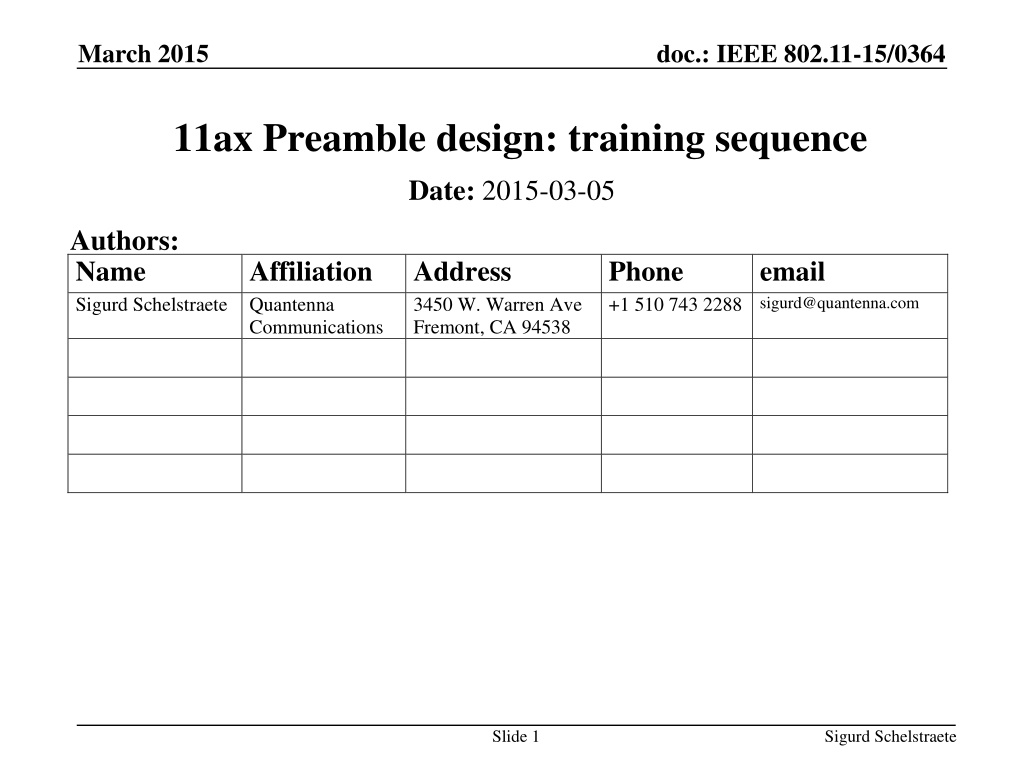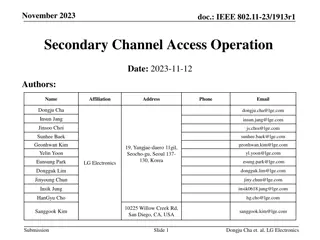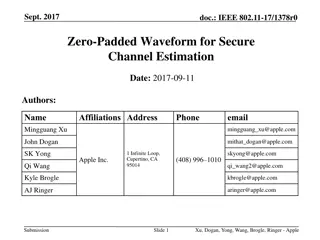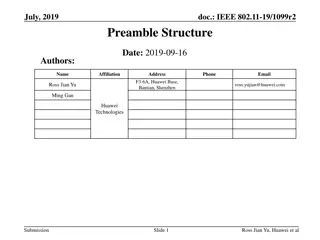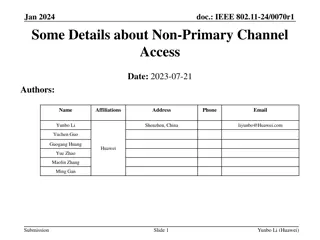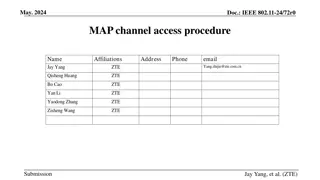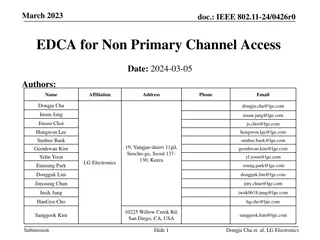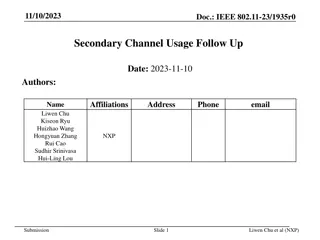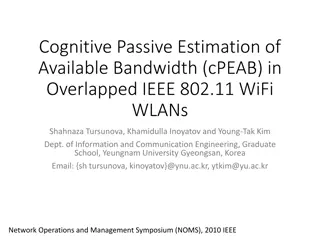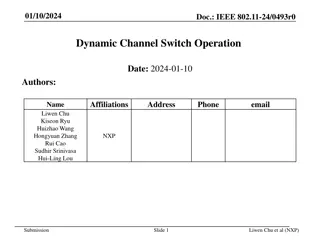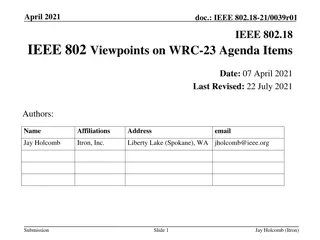IEEE 802.11-15/0364: Channel Estimation Considerations in Wi-Fi Standards
Channel estimation in IEEE 802.11 standards, such as 11n, 11ac, and 11ax, is crucial for efficient MIMO systems. The noise impact during data reception affects the quality of the channel estimate, leading to SNR reduction post-equalizer. Techniques like channel smoothing and averaging of training sequences can improve the channel estimate quality and overall SNR performance.
Download Presentation

Please find below an Image/Link to download the presentation.
The content on the website is provided AS IS for your information and personal use only. It may not be sold, licensed, or shared on other websites without obtaining consent from the author. Download presentation by click this link. If you encounter any issues during the download, it is possible that the publisher has removed the file from their server.
E N D
Presentation Transcript
March 2015 doc.: IEEE 802.11-15/0364 11ax Preamble design: training sequence Date: 2015-03-05 Authors: Name Sigurd Schelstraete Quantenna Affiliation Address 3450 W. Warren Ave Fremont, CA 94538 Phone +1 510 743 2288 sigurd@quantenna.com email Communications Slide 1 Sigurd Schelstraete
March 2015 doc.: IEEE 802.11-15/0364 Introduction MIMO Channel estimation is done using dedicated training sequence HT-LTF in 11n VHT-LTF in 11ac HE-LTF in 11ax? In 11ac, the length of the training sequence is the minimum needed to estimate NRX x NSTS,total channel Slide 2 Sigurd Schelstraete
March 2015 doc.: IEEE 802.11-15/0364 Considerations for channel estimation Channel estimation is affected by the same noise level that is present during data reception The channel estimate is noisy Equalizer coefficients derived from the noisy channel estimate propagate the noise to the equalized constellation points This effectively leads to a doubling of the noise or a 3dB reduction in post-equalizer SNR compared to noise-free channel estimate Slide 3 Sigurd Schelstraete
March 2015 doc.: IEEE 802.11-15/0364 Some math Received training signal is: The channel can be derived as: Received data signal is: (?? is Gaussian with variance 2) ??= ???+ ?? ( ? is Gaussian with variance 2) ? = ???? = ? + ? = ? + ???? ? = ?? + ? This can be equalized as: ? ? ? ? ? ??? + ?? ???? ? = ? = ?? = ?2 ?2 This can be rewritten as: ? ? ? = ? + ? (? ??) ?????= ? = ? ? ? + ?? 3 dB Loss ?2 ??2 ?????????= ????? ??? ???????? 2?2 Slide 4 Sigurd Schelstraete
March 2015 doc.: IEEE 802.11-15/0364 Simulation result Noisy channel estimate vs. Noise-free channel estimate Slide 5 Sigurd Schelstraete
March 2015 doc.: IEEE 802.11-15/0364 How too improve the channel estimate? Channel smoothing can be used Not for precoded signals Data-driven Equalizer adaptation Doesn t provide improvement for early symbols Channel estimate can be improved by averaging Averaging becomes possible if training sequences are increased N symbols: noise variance on channel estimate is ?2/N instead of ?2 Total noise after Equalizer becomes ?2(1+1/N) instead of 2?2 N 2 4 8 Theoretical SNR improvement 1.25 dB 2.04 dB 2.5 dB Slide 6 Sigurd Schelstraete
March 2015 doc.: IEEE 802.11-15/0364 Example: one-stream performance Compare performance of one-stream MCS with 1, 2, 4 or 8 VHT-LTF symbols SNR 1.1 dB 1.8 dB 2.0 dB N 2 4 8 Slide 7 Sigurd Schelstraete
March 2015 doc.: IEEE 802.11-15/0364 Complexity A small additional overhead can provide 1.5-2 dB improvement in EVM 4 microsec for 2 training symbols (NOTE: based on 11ac preamble structure) 12 microsec for 4 training symbols The same overhead that is already incurred for multi- stream transmissions Straightforward extension of current VHT-LTF coding (at Tx and Rx) Overall: very low complexity Slide 8 Sigurd Schelstraete
March 2015 doc.: IEEE 802.11-15/0364 How to use this technique in 11ax? Several possibilities: Use fixed training length, independent of number of streams (e.g. 4 symbols) MCS with lower number of streams can improve channel estimate MCS with higher number of streams don t increase overhead relative to 11ac Keep it configurable and indicate training length in HE-SIG Configurable mapping of number of streams to number of training symbols Increase training sequence length for all MCS Fixed mapping, but more training symbols than comparable 11ac case Slide 9 Sigurd Schelstraete
March 2015 doc.: IEEE 802.11-15/0364 Conclusion Increased training lengths are a very efficient and low- complexity way to gain 1.5-2 dB in EVM In practice, there are several ways to implement increased training lengths Slide 10 Sigurd Schelstraete
March 2015 doc.: IEEE 802.11-15/0364 Strawpoll Do you support investigating the use of longer training signal lengths during HE-LTF to allow averaging when estimating the channel? Slide 11 Sigurd Schelstraete
